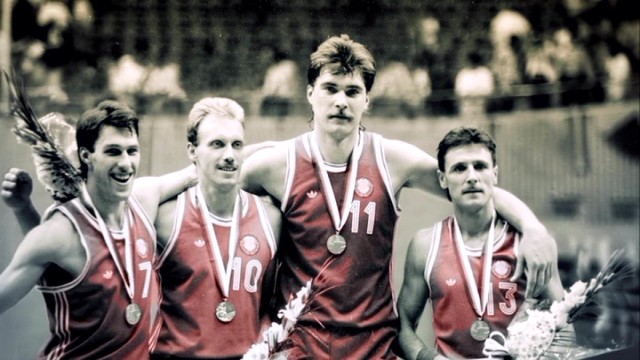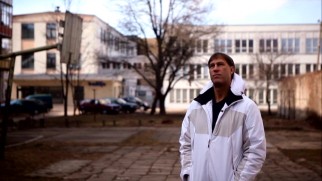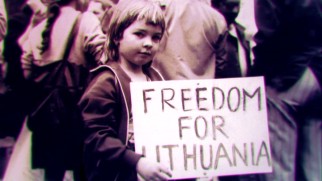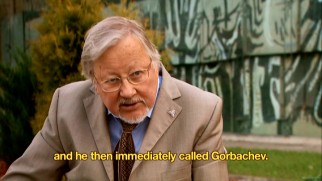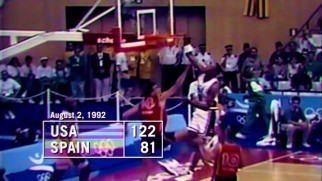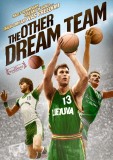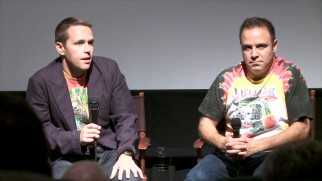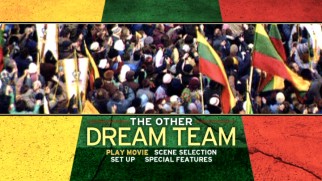The Other Dream Team DVD Review
 |
The Other Dream Team
Theatrical Release: September 28, 2012 / Running Time: 91 Minutes / Rating: Not Rated Director: Marius A. Markevicius / Writers: Marius A. Markevicius, Jon Weinbach Interview Subjects: Valdas Adamkus, Kim Bohuny, Juozas Butrimas, P.J. Carlesimo, Valdemaras Chomicius, Chad Ford, Fran Fraschilla, Vladas Garastas, Mickey Hart, Žydrunas Ilgauskas, Sergejus Jovaiša, Arturas Karnišovas, Jim Lampley, Vytautas Landsbergis, Dan Majerle, Šarunas Marciulionis, Dennis McNally, Chris Mullin, Donnie Nelson, Arturas Poviliunas, David Remnick, Mitch Richmond, Arvydas Sabonis, Tommy Sheppard, Charles Smith, Greg Speirs, David Stern, Jonas Valanciunas, Danute Valanciunas, Alexander Volkov, Bill Walton, Alexander Wolff Tagline: Most Olympians dream of gold... Their dream was freedom. |
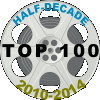 | The Other Dream Tream ranks 94th in our list of the Top 100 Movies of the Half-Decade (2010-2014). |
Buy The Other Dream Team from Amazon.com: DVD • Instant Video
If you were alive in 1992 and cognizant of the world around you, then you know that The Dream Team was a big deal. For the first time in history, established NBA players were deemed eligible for Olympic competition. This was better than an All-Star Game; it was like an All-NBA Team on a world tour, steamrolling any nation that dared to challenge them. The best way my young self could convey this excitement was to keep score while watching every game, calculating at least the points that each player logged and then comparing my findings to the official box scores in the next day's newspaper.
Though blowouts generally make for boring basketball games, the original Dream Team treated the universe to them again and again, providing the dominance that everyone expected. Beginning with the Tournament of the Americas in Portland, Oregon and continuing with the Olympics themselves in Spain, the US team went 14-0, their closest matches being 32 and 33-point victories over the Croatian team that would ultimately win the silver medal.
Twenty years later, Dream Team Fever resurfaced to a small degree. No, the return wasn't fueled by 2012's U.S. Men's team, 13-0 and gold medalists led by Kevin Durant and LeBron James, but by memories of the monumental 20-year-old squad. It was as if the clocks had been turned back, when life-sized cardboard standees of Bird, Scottie Pippen, and David Robinson loomed large over my closest supermarket's soft drink aisle, their likenesses also adorning specially marked cans of 7 Up, Sunkist, and A & W Root Beer. The team even got a brand new, much-advertised documentary that gathered reflections from every player (even the still glaringly out-of-place Laettner) and emphasized the juicy story of how a team of NCAA college stars defeated the elite NBAers in one heated practice scrimmage. The documentary set a ratings record for NBA TV, with 847,000 viewers tuning in to its premiere.
Meanwhile, last fall, initially two and eventually 14 theaters in the United States exhibited The Other Dream Team, a documentary on the '92 Lithuanian Olympic basketball team, a team representing a newly independent nation. While everyone knows that theatrical release trumps television, it probably isn't fair to cite these two concurrent films as the Dream Team's first defeat. After all, The Other Dream Team is estimated to have sold a total of 17,400 tickets, reaching far fewer paying moviegoers than the NBA TV special reached paid subscribers. Still, The Other Dream Team hits DVD on Tuesday, while NBA TV's documentary on the U.S. team has not yet been deemed worthy of home video release.
Lithuania's team was led by two players who would enjoy distinguished NBA careers in the 1990s: 7-foot-3 center Arvydas Sabonis and 6-foot-5 shooting guard Sarunas Marciulionis. Appropriately enough, the two are the most prominent of The Other Dream Team's thirty-two interview subjects. Their small homeland is described as being a mid-20th Century chess piece to the two European super powers it stood between: Nazi Germany and the Soviet Union. After twenty years of independence between the World Wars, Lithuania and its fellow Baltic states became Soviet republics, living in poverty under Communist command.
For Marciulionis and Sabonis, born both in the city of Kaunas in 1964, the land's preferred sport of basketball emerged as their outlet from a legacy of hardship extending back to when their ancestors and other families were deported to Siberian gulags following World War II. Unusual athletic ability gave the players more freedom than most of their neighbors in Lithuania, where getting a car required a ten-year wait. But the players were required to represent not their state, but the USSR. They and their teammates recall having a KGB agent as team manager on their international travels. Poorly paid and closely watched, the players industriously made do by buying foreign products and reselling them for profit (a practice that was illegal under the laws of a place that had no word for "businessman") and got their kicks by sneaking out at night in trunks of cars.
Marciulionis and Sabonis were both part of the 1988 Soviet Union team that surprised the United States in the semi-finals at Seoul, dealing the U.S. only its second loss in Olympic basketball competition following the Soviet Union's bizarre 1-point defeat of America in the controversial and much-contested gold medal match in 1972 Munich. Members of the '88 U.S. team, including Marciulionis' future NBA teammate Mitch Richmond, recall their narrow loss in South Korea, while the limitations of that Gold Medal achievement are acknowledged in that four of the Soviet's five starters identified themselves not as Russian, but as Lithuanian.
The film is as interested in the politics as in the on-court heroics of Lithuania's star players. In 1989, with Eastern Europe starting to be dramatically made over, Marciulionis made the bold and risky move of signing with Golden State Warriors, joining the likes of future Dream Teamer Chris Mullin (another notable interview subject). Meanwhile back home, Lithuania found itself in a quagmire when its declaration of independence was met with Soviet tanks and gunfire in the night. This upheaval was recent backstory for the swiftly-established Lithuanian national basketball team to compete in Barcelona. While people around the world and even professional athletes from other countries were fixated on the participation of Michael Jordan and his fellow Dream Teamers, with the NBA's popularity at an all-time high, here was this small European nation of 3 million people finally allowed to declare and acknowledge its unique heritage independent of the Soviet Union. While the incalculable benefits of global exposure were making themselves known to NBA commissioner David Stern, Marciulionis and his Warriors/Lithuania assistant coach Donnie Nelson, son of Warriors head coach Don Nelson, were trying to scrounge enough funds just to compete. A newspaper article would help them land a valuable partnership with rock band The Grateful Dead, who would provide some financial backing and dress the team in attention-grabbing tie-dyed T-shirts and other clothing featuring a dunking skeleton (a variation on the band's iconic emblem) and the colors of Lithuania's flag.
Clearly, there was more at stake than just basketball pride and international bragging rights. Lithuania's game against the Dream Team, in which they were decimated by 51 points, the U.S.'s second biggest win margin that summer, assumes less importance than the young nation's next match against the Soviet Union's successor, the Unified Team that had defeated them just eight days earlier. The significance of the Bronze Medal rematch is deftly established as adding to a tradition of closely-watched, highly competitive Soviet Red Army-(Lithuania) Zalgiris Kaunas games ripe with political implications.
The Other Dream Team complements its inspiring central story of independence with looks at the promising Lithuanian NBA prospect Jonas Valanciunas, born in 1992, whose unremarkable selection in the Toronto Raptors' 5th overall draft pick offers stark contrast to Stern's snarky announcement of the Portland Trail Blazers' choice of Sabonis with the last first round pick in 1986, during what would be the final lap of the long Cold War. The quarter-century that has passed between those two NBA Drafts has changed the world in countless ways, but it is the faster change between those two times that affected a rather small portion of the globe which makes this film so arresting.
VIDEO and AUDIO Like many documentaries, The Other Dream Team varies in picture quality based upon the many sources it employs. The newly-filmed material looks great in the DVD's 1.78:1 anamorphic widescreen presentation. Game footage is either matted to fit that aspect ratio or pillarboxed to its original 1.33:1 aspect ratio. The NBA game footage is stylized to give it a kind of cinematic look with contrasting hues. News footage retains the limitations and design of their original broadcast. The substantive Dolby Digital 5.1 soundtrack offers crisp dialogue and does a fine job of distributing fitting music from the Grateful Dead and others. Most of the interviews are conducted in Lithuanian and translated by burned-in yellow English subtitles. On the whole, while the new material would benefit from a Blu-ray, the rest probably would not and the DVD shouldn't strongly disappoint anyone visually or aurally.
BONUS FEATURES, MENUS, PACKAGING and DESIGN Though the disc contains just two bonus features, they are substantial and likely to satisfy. First comes an audio commentary by writer/director Marius A. Markevicius and writer/producer Jon Weinbach.
Next and last, we get a Q&A session (13:27) with the same two filmmakers, recorded last September after one of the film's screenings at The Landmark theatre in Los Angeles. Questions transcribed on screen get thoughtful responses regarding the emotional production, things that took shape over years of shooting, the history discussed in the film, and interview subjects they wanted but couldn't get (e.g. David Robinson). The DVD opens with trailers for More Than a Game, Facing Ali, 24x24: Wide Open with Jeff Gordon, The Winning Season, and Step Into Liquid, plus an updated promo for EPIX. All the same ads play in the same order from the extras menu's "Also from Lionsgate" listing. Too bad The Other Dream Team's trailer isn't included. The scored main menu plays wide clips in a rectangle bordered by the Lithuanian colors, which the submenu makes further use of along with either static imagery or more score and clips. The plain gray disc is held in an Eco-Box keepcase with no inserts or slipcover.
CLOSING THOUGHTS As someone who likes basketball and loves film but isn't terribly interested in history or documentaries, I found The Other Dream Team to be pretty terrific. The supremely engaging human interest material almost doesn't even use (or need to) the star-studded U.S. Dream Team's connection to give context and relevance to this moving tale. Though some will lament the lack of a Blu-ray, Lionsgate's DVD boasts a perfectly satisfying standard definition presentation plus two substantial, worthwhile extras. It's an easily-missed disc I recommend without hesitation to anyone interested. Buy The Other Dream Team from Amazon.com: DVD / Instant Video
|
Related Reviews:
DVDizzy.com | DVD and Blu-ray Reviews | New and Upcoming DVD & Blu-ray Schedule | Upcoming Cover Art | Search This Site
DVDizzy.com Top Stories:
Basketball: Thunderstruck • Through the Fire • The Mighty Macs • Teen Wolf • Air Bud • Semi-Pro
True Sports Dramas: Miracle • Remember the Titans • Invincible • The Rookie • Secretariat • The Fighter • Soul Surfer • A League of Their Own
New: Trouble with the Curve • Seal Team Six: The Raid on Osama Bin Laden
Documentaries: Beats, Rhymes & Life: The Travels of A Tribe Called Quest • Waiting for "Superman" • Chimpanzee
Produced by Marius A. Markevicius: The Way Back • Like Crazy
Text copyright 2013 DVDizzy.com. Images copyright 2012 The Film Arcade, Sorrento Productions, Berliner 76 Entertainment, The Basketball Future Foundation, and 2013 Lionsgate.
Unauthorized reproduction prohibited.
